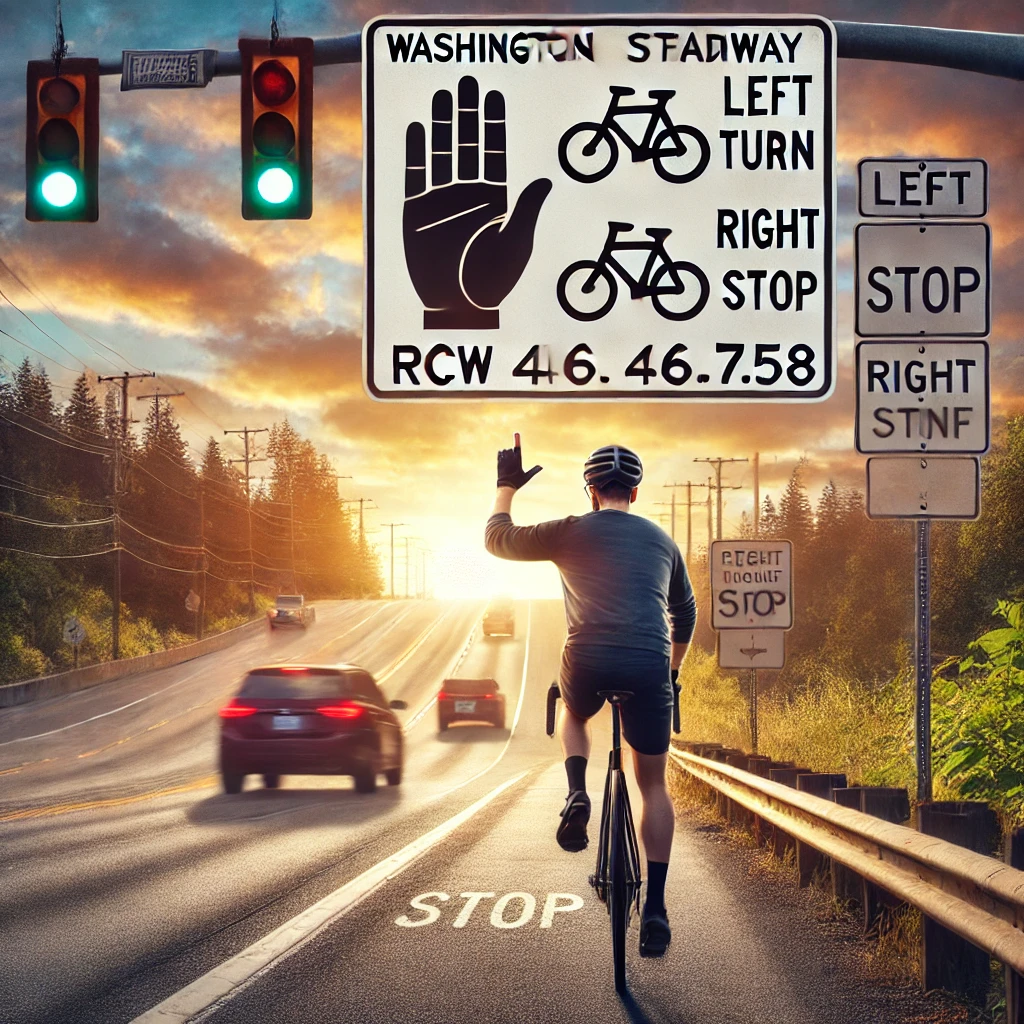Introduction: RCW 46.61.758 outlines the proper hand signals that cyclists in Washington State must use to communicate their intentions on the road. These signals are crucial for ensuring the safety of both cyclists and motorists, allowing for clear communication and reducing the risk of accidents. This article explores the specific hand signals required by RCW 46.61.758 and the importance of using them correctly.
Key Provisions of RCW 46.61.758:
- Left Turn Signal (Subsection 1):
To indicate a left turn, cyclists must extend their left hand and arm horizontally beyond the side of the bicycle. This signal should be given well before the turn to alert drivers and other cyclists of the intended maneuver, ensuring a smooth and safe transition. - Right Turn Signal (Subsection 2):
For a right turn, cyclists have two options: they can either extend their left hand and arm upward beyond the side of the bicycle or extend their right hand and arm horizontally to the right side. These signals are designed to be easily visible to other road users, helping to prevent misunderstandings or collisions during right turns. - Stop or Decrease Speed Signal (Subsection 3):
When intending to stop or slow down, cyclists must extend their left hand and arm downward beyond the side of the bicycle. This signal is particularly important in heavy traffic or when approaching intersections, as it alerts others that the cyclist is reducing speed or coming to a stop.
Importance of Hand Signals in Road Safety: Hand signals are a simple yet effective way for cyclists to communicate their intentions on the road. By following the guidelines set forth in RCW 46.61.758, cyclists can help prevent accidents and ensure a safer environment for everyone. These signals are especially important in areas with heavy traffic or limited visibility, where clear communication is key to avoiding collisions.
For more details on this statute, you can review the full text of RCW 46.61.758 here.
Conclusion: RCW 46.61.758 provides essential guidelines for cyclists to communicate their intentions clearly and effectively using hand signals. By understanding and utilizing these signals, cyclists can contribute to safer roadways in Washington State.
Additional Resources:
- Is a Turn Signal Always Required When You Turn or Change Lanes?
This article explores Washington State laws on turn signal use, clarifying when and where drivers are legally required to signal before turning or changing lanes. - 21 FAQs: Security at Pierce County Court
Answers to common questions about security protocols at Pierce County Court, covering what to expect and guidelines for visitors and defendants. - Two Snowmobilers Injured in 50-Foot Embankment Fall Near Snoqualmie Pass
Details of a snowmobiling accident near Snoqualmie Pass, where two individuals were injured in a fall, emphasizing the importance of safety precautions in winter sports. - Understanding RCW 46.61.750: Regulations and Penalties for Bicyclists in Washington State
A guide to RCW 46.61.750, explaining the regulations that Washington bicyclists must follow and the penalties for non-compliance. - Understanding RCW 46.61.760: Safe Riding Practices for Bicyclists in Washington State
Overview of RCW 46.61.760, focusing on recommended safe riding practices for bicyclists in Washington to enhance safety and reduce accident risks.
Additionally, explore our client resources here for more details on how we handle similar cases.
About Blanford Law:
At Blanford Law, we are committed to providing relentless, fair, and honest legal representation. With over 20 years of experience, Ken Blanford founded our firm on the belief that every client deserves respect and the best possible defense, free from assumptions or preconceived notions. If you or someone you know is facing criminal charges or has been injured due to someone else’s negligence, please contact us anytime at 253-720-9304 or email us at info@blanfordlaw.com.

